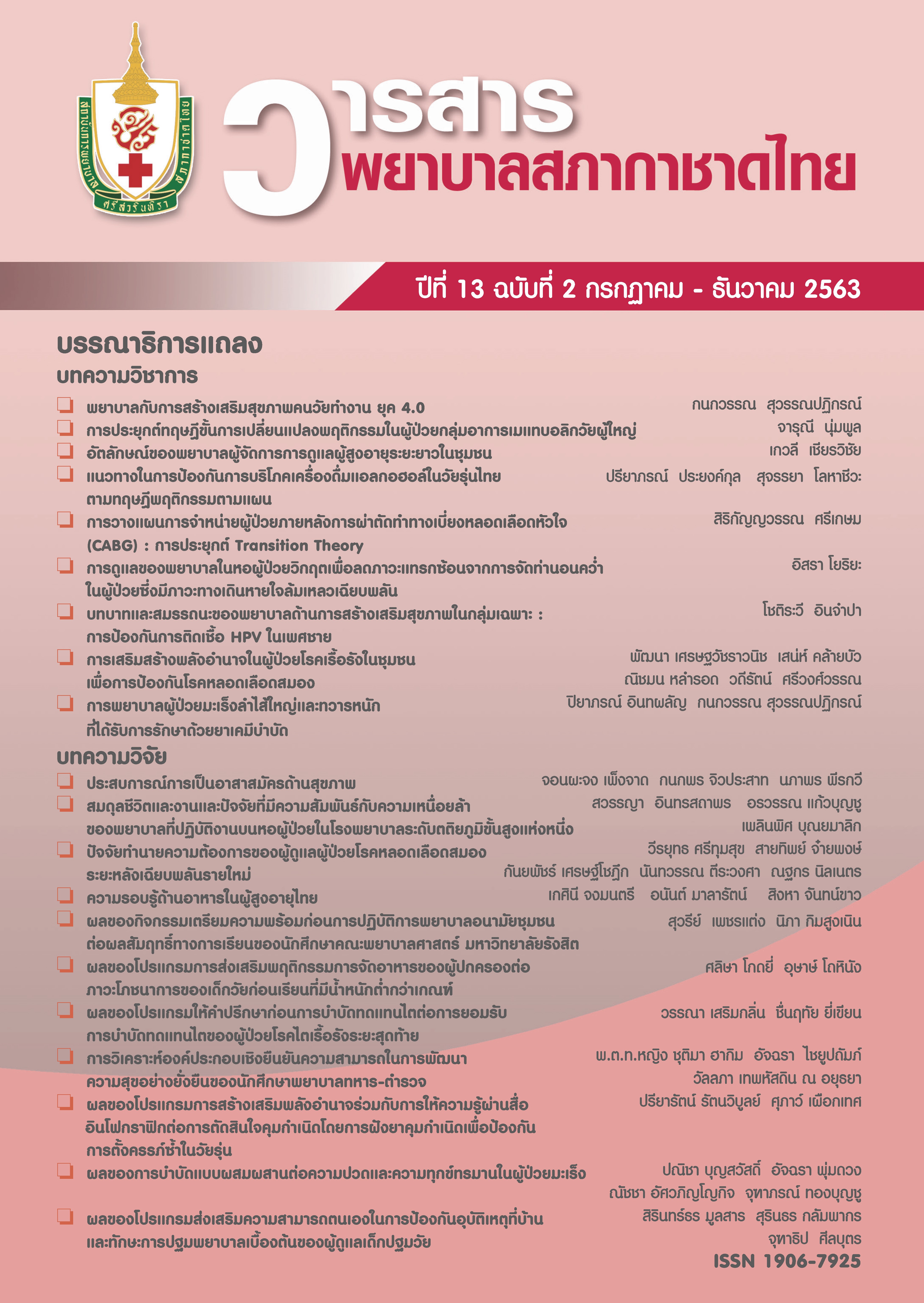The Effect of Complementary and Integrative therapy on Pain and Pain Distress in Patients with Cancer
Keywords:
complementary and integrative therapy, cancer pain, pain distress, acupressure, Therapeutic massage, healing touchAbstract
This Quasi-Experimental research with a two group pre-test and post-test repeated design aimed to compare the effects between the integrative complementary therapy and the routine nursing care on pain and pain distress with cancer patients hospitalized in the cancer department at King Chulalongkorn Memorial Hospital. Data was collected from November 2014 to March 2015 from 15 cases in an experimental group who received the integrative complementary therapy treatment (massage, acupressure, and healing touch) for 15 minutes for two days, and 17 cases as the control group who received routine nursing care. Pain and pain distress were assessed by Johnson’s Two Components Scale measurement. Data were collected before and after treatment at all trials at 0, 15, 30 minutes and 24 hours for two days then analyzed by Wilcoxon matched-pairs test and Mann-Whitney U test.
The results revealed that the experimental group’s mean scores of pain and pain distress level of day1 (x̅ = 4.6, 4.6) and day 2 (x̅ = 3.0, 3.5) were significantly lower (p≤0.01, ≤0.01) after all trails treatment. The level of pain between the experiment group and the control group of day 1 (x̅ = 4.6, 3.0 p≤.007) and day 2 (x̅ = 3.0, 2.8, p≤.5) was found significantly different (p≤.01, p≤.001) after all trails treatment. The level of pain distress between the experiment group and the control group of day 1 (x̅ = 4.6, 2.5 p≤.002)and day 2 (x̅ = 3.5, 2.3, p≤.053) was found significantly different (p≤.01, p≤.001) after all trails treatment.
References
2. Nilmanat K, Chailangka P, Phungrassami T, Promnoi C, Tulathammakit K. Noourai P, et al. The dying experience: a case study of patients with terminally advanced cancer. Songkla: Prince of Songkla University; 2009. (in Thai)
3. Singh P, Chaturvedi A. Complementary and alternative medicine in cancer pain management: a systematic review. Indian J Palliat Care 2015;21(1):105–15.
4. Niruttisart S. Unravel management of neuropathic pain in cancer patients. In: Euasobhon P, Yeephu S, Tantisiriwat N, editors. Novel pain management: the 29th TASP Annual Scientific Meeting; 2018 Mar 15-17. Bangkok: Thai Association for the Study of Pain; 2018. p 47-52. (in Thai)
5. IASP. Pain 2010-an updated review: refresher course syllabus [Internet]. 2010 [cited 2017 Dec 20]; 27-36. Available from: http://ebooks.iasp-pain.org/pain_2010_ refreshercourse_syllabus
6. Pan CX, Morrison RS, Ness J, Fugh-Berman A, Leipzig RM. Complementary and alternative medicine in the management of pain, dyspnea, and nausea and vomiting near the end of life. A systemic review. J Pain Symptom Manage 2000;20(5):374-87.
7. O’Conner S, Heck C, Peltier C. Complementary and integrative therapies for pain management. In: Czarnecki ML, Turner HN. Core curriculum for pain management nursing. 3rd ed. St. Louis: Elsevier; 2018. p.505-32.
8. Sungsing K , Hatthakit U, Aphichato A. Cancer patient's experiences in using meditation for self-healing. Songkla Med J 2007;25(1):39-48. (in Thai)
9. Sangchart B. The effect of imagining on pain and anxiety in breast cancer patients. J Sci Technol MSU 2005;24(1):58-66. (in Thai)
10. Boonsawad W. Effects of Thai traditional massage on pain reduction in cancer patients. [Thesis]. Songkla: Songkla University; 2001. (in Thai)
11. Theppaya T. Effects of modified traditional Thai massage on pain and pain distress in patients with cancer [Thesis]. Khon Kaen: Khon Kaen University; 2003. (in Thai)
12. Mennick F, Chu JJ. Managing cancer symptoms with massage therapy. Am J Nurs 2005;105(3),72G-72H.
13. Pianbanyat K, Choowattanapakorn T. The effect of nursing process combined with swedish massage on pain in older persons with lung cancer. Kuakarun Journal of Nursing 2015;22(1):98-112. (in Thai)
14. Serce S, Ovayolu O, Pirbudak L, Ovayolu N. The effect of acupressure on pain in cancer patients with bone metastasis: a nonrandomized controlled trial. Integr Cancer Ther 2018;17(3):728-36.
15. Post-White J, Kinney ME, Savik K, Gau JB, Wilcox C, Lerner I. Therapeutic massage and healing touch improve symptoms in cancer. Integr Cancer Ther 2003;2(4):332-44.
16. Wardell DW, Rintala HD, Duan Z, Tan G. A pilot study of healing touch and progressive relaxation for chronic neuropathic pain in persons with spinal cord injury. J Holist Nurs 2006;24(4):231-40.
17. Maindet C, Burnod A, Minello C, George B, Allano G, Lemaire A. Strategies of complementary and integrative therapies in cancer-related pain-attaining exhaustive cancer pain management. Support Care Cancer 2019;27(8):3119-32.
18. Rizi MS, Shamsalinia A, Ghaffari F, Keyhanian S, Naderi Nabi B. The effect of acupressure on pain, anxiety, and the physiological indexes of patients with cancer undergoing bone marrow biopsy. Complement Ther Clin Pract 2017;29:136-41.
19. Giasson M, Bouchard L. Effect of therapeutic touch on the well-being of person with terminal cancer. J Holist Nurs 1998;16(3):383-98.
20. Srisongmuang O, Karomprat A, Chinrat M , Chindaprasirt J. The effect of foot reflexology program to relieve pain in patients with cancer. Srinagarind Med J 2020;35(3):296-303. (in Thai)
Downloads
Published
Issue
Section
License
เนื้อหาบทความหรือข้อคิดเห็นต่างๆ ในวารสารพยาบาลสภากาชาดไทยนี้ เป็นความคิดเห็นของผู้เขียนบทความ ไม่ใช่ความเห็นของกองบรรณาธิการ หรือสถาบันการพยาบาลศรีสวรินทิรา สภากาชาดไทย






